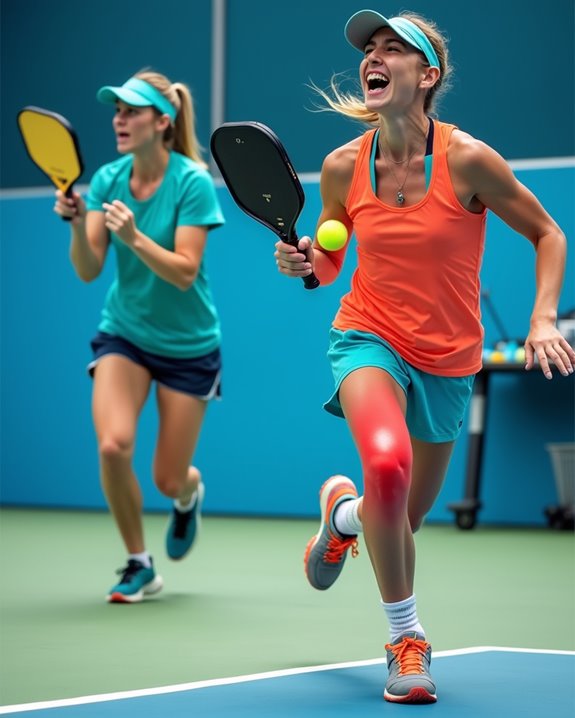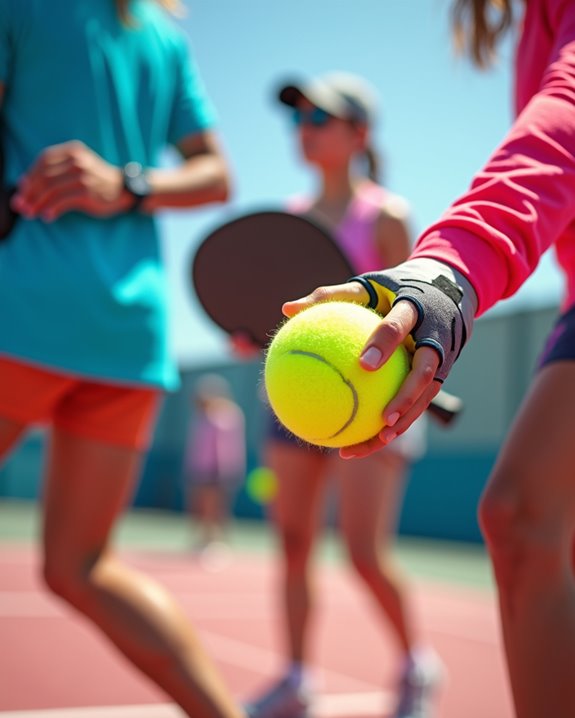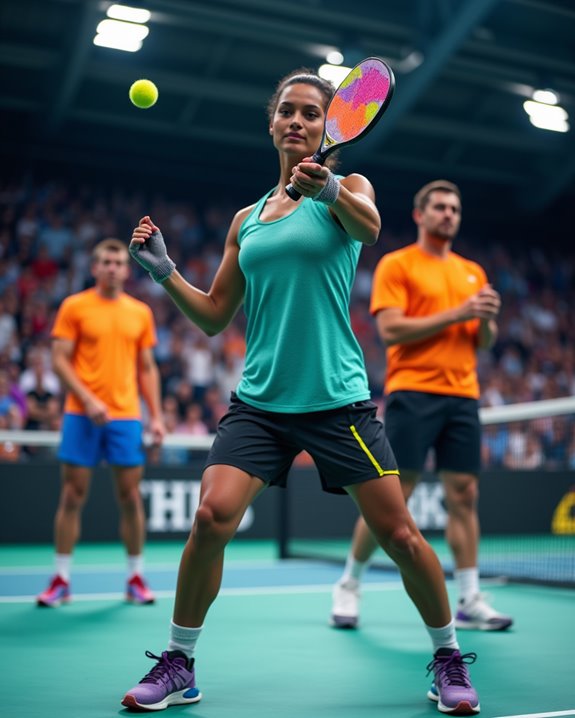Pickleball knee pain typically stems from quick pivots and repetitive movements that strain your joints. You can prevent injuries by warming up properly, wearing supportive court shoes, and strengthening knee-stabilizing muscles. When pain strikes, apply ice, rest, and consider over-the-counter anti-inflammatories. Don’t ignore persistent discomfort—seek medical evaluation. A proper rehabilitation program focusing on knee-supporting exercises guarantees you’ll return to the court with confidence. The following techniques will transform your pickleball experience from painful to pleasurable.
Key Takeaways
- Rapid direction changes and stop-and-go movements in pickleball commonly cause patellar tendinitis, meniscus tears, and IT band syndrome.
- Proper warm-up with dynamic stretching and wearing supportive court shoes significantly reduces knee injury risk.
- Strengthening quadriceps and hamstrings through regular exercise creates stability and protection for the knee joint.
- Apply ice, rest, and take anti-inflammatory medications for immediate relief of pickleball-related knee pain.
- Seek medical evaluation if pain persists, and only return to play when movement is completely pain-free.










Understanding Common Knee Injuries in Pickleball Players
The snap, crackle, and pop of pickleball joints isn’t the recipe for success you’re looking for on the court! With nearly 19,000 pickleball injuries simmering annually, your knees often bear the brunt of the game’s rapid direction changes.
You’ll find Patellar Tendinitis (Jumper’s Knee) commonly served up alongside Meniscus Tears on this unwanted menu of knee injuries in pickleball. Runners Knee, or IT Band Syndrome, is another frequent dish caused by the repetitive stress you place on your joints during intense rallies.
To prevent injuries, don’t skip your warm-up—it’s like preheating your oven before baking! Proper footwear provides the foundation for your pickleball recipe, while listening to your body’s cues helps you avoid overcooking your knees on the court.
How Pickleball Movements Impact Knee Health
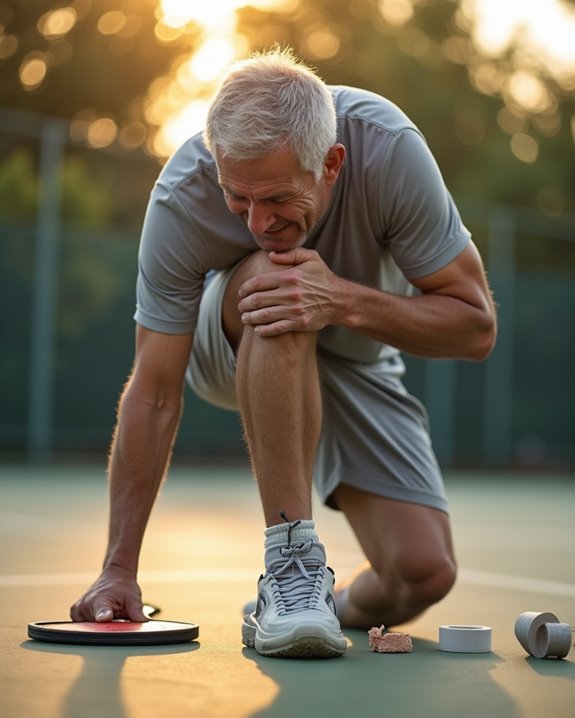
While you’re dashing across the court to return that perfect dink, your knees are silently absorbing forces that can simmer into serious problems if left unchecked. The stop-and-go rhythm of pickleball—much like folding ingredients into a delicate batter—requires your knees to constantly shift and stabilize.
Those sudden movements when you pivot to catch a wide shot create significant strain, especially if you’re playing without proper warm-up. Like a pot that boils over, overuse injuries develop gradually as repetitive stress accumulates in your knee joints. Your footwear serves as the foundation of knee protection—worn-out shoes are like dull knives in the kitchen: ineffective and potentially dangerous. Investing in shoes with podiatrist-certified arch support can significantly enhance comfort and protect your knees during gameplay.
Don’t ignore the early whispers of knee pain. Your body’s signals deserve the same attention as a timer on your oven.
Essential Prevention Strategies for Knee Pain
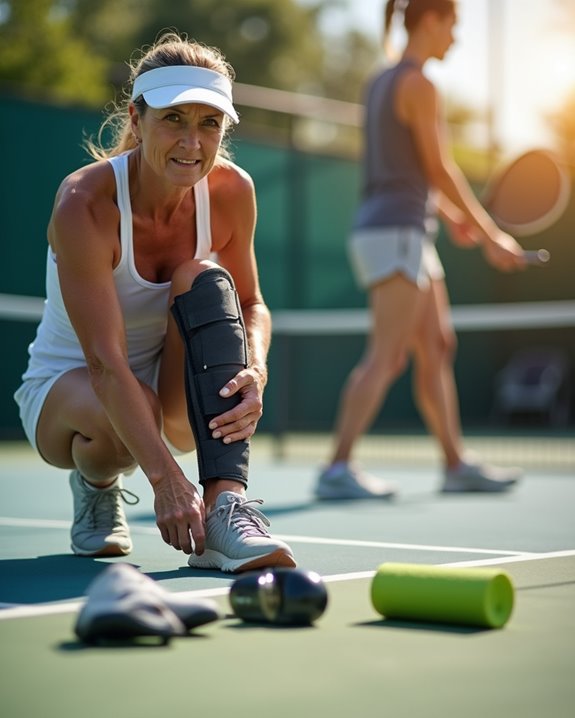
Prevention serves as your first line of defense against knee pain—just like a chef’s mise en place prepares for a smooth cooking process. You’ll want to simmer in a proper warm-up routine that includes dynamic stretching before hitting the court, priming your muscles like heating a pan before adding ingredients.
Don’t skimp on proper footwear! Just as a chef needs the right knife, you need court shoes that support your knees during those lightning-quick pivots. Fold strength training into your regimen, focusing on quadriceps and hamstrings—the essential ingredients that stabilize your knees.
When your body whispers discomfort, listen! Ignoring pain is like letting a pot boil over. Physical therapy can be your secret sauce for addressing issues before they become knee injuries. Finally, maintain a healthy weight to reduce strain on your knees.
Effective Treatment Options for Pickleball-Related Knee Pain
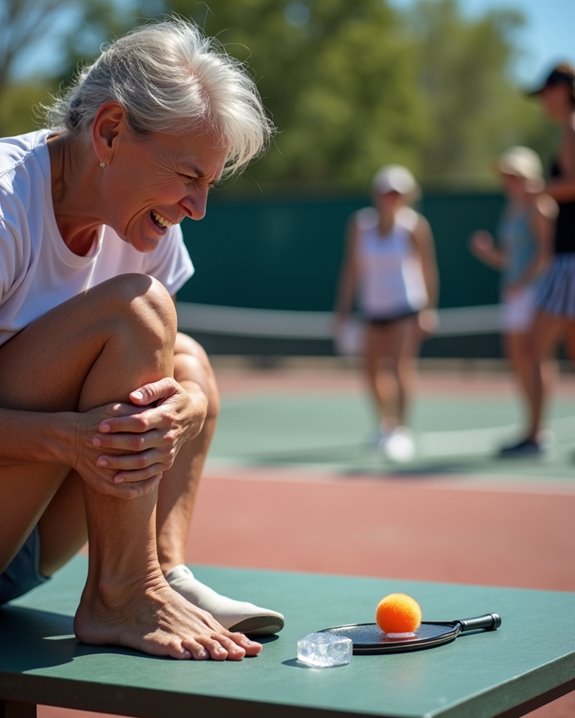
When knee pain crashes your pickleball party like a fallen soufflé, immediate action becomes your recipe for recovery. Start by folding ice and rest into your treatment, allowing 15-20 minutes of cold therapy to reduce swelling—your perfect first course for healing.
For pain relief, whisk in over-the-counter medications like ibuprofen, which help simmer down inflammation while you rest. Don’t skip the medical evaluation if pain persists—doctors will serve up a diagnosis that’s essential for proper healing.
Physical therapy offers a carefully crafted menu of exercises to strengthen your knee, while a supportive knee brace can provide stability when you’re ready to return to the court. Remember, recovery should be marinated slowly—rushing back to play too quickly will only result in a reinjury soufflé nobody wants to taste!
Returning to Play: Rehabilitation Techniques for Long-Term Knee Health
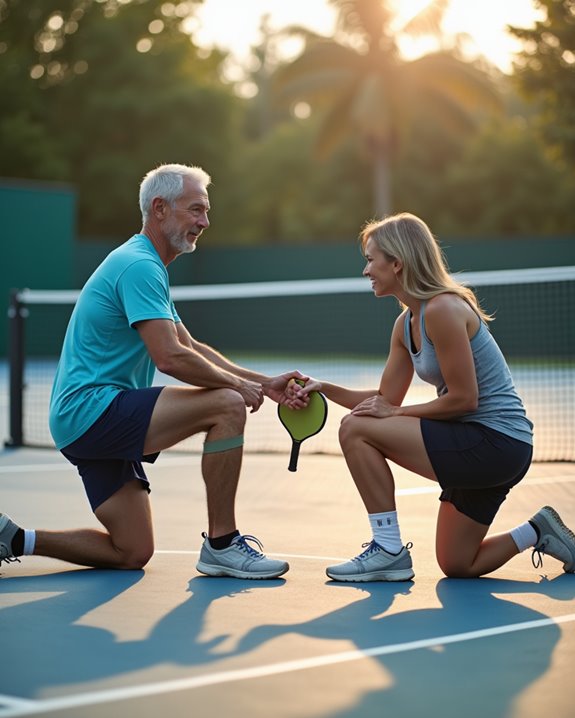
After your knee has simmered in recovery mode, it’s time to carefully fold yourself back into the pickleball recipe. Your rehabilitation techniques should be as personalized as a signature sauce, incorporating physical therapy to strengthen your knee joint’s foundation.
Begin by whisking in proper warm-ups with dynamic stretches that prepare your muscles for the court’s demands. You’ll want to simmer in exercises that target knee-supporting muscles—think of these as the roux that prevents future injuries from thickening your recovery timeline.
Listen to your body’s flavor signals! If pain sizzles during movement, reduce the heat and rest. Only serve yourself back onto the court when movement becomes pain-free. By consistently monitoring your knee’s condition and following medical guidance, you’ll create a sustainable recipe for pickleball longevity.
Frequently Asked Questions
How to Prevent Pickleball Knee Pain?
To prevent knee pain, you’ll need knee support with proper footwear that stabilizes your joints. Don’t skip warm up exercises to prepare your muscles, and remember to take breaks when you’re feeling strain.
How to Strengthen Your Knees for Pickleball?
Did you know 60% of pickleball players experience knee issues? Strengthen your knees with quad sets, lunges, and wall sits. These knee strengthening exercises, combined with proper pickleball training tips, are essential injury prevention strategies.
What Can I Take to Make My Knees Stop Hurting?
For knee pain relief options, try over-the-counter anti-inflammatory remedies like ibuprofen or naproxen. Apply ice regularly, wear knee support during activities, and consider glucosamine supplements. Rest when needed and elevate your legs after activity.
How Do You Relieve Pickleball Pain?
To relieve pickleball pain, you’ll need effective stretching routines before playing, proper knee support options during matches, and pain management techniques like icing afterward. Don’t forget to strengthen supporting muscles between games.

